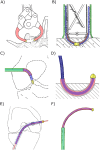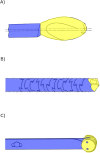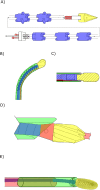Drilling around the corner: a comprehensive literature review of steerable bone drills
- PMID: 40271520
- PMCID: PMC12016042
- DOI: 10.3389/fmedt.2025.1426858
Drilling around the corner: a comprehensive literature review of steerable bone drills
Abstract
Introduction: Orthopedic procedures often require drilling of tunnels through bone, for instance for the introduction of implants. The currently used rigid bone drills make it challenging to reach all target areas without damaging surrounding anatomy. Steerable bone drills are a promising solution as they enable access to larger volumes and the creation of curved tunnels thereby reducing the risk of harm to surrounding anatomical structures.
Method: This review provides a comprehensive overview of steerable bone drill designs identified in patent literature via the Espacenet database and in scientific literature accessed via the Scopus data base. A Boolean search combined with pre-set inclusion criteria returned 78 literature references describing a variety of drill designs.
Results: These drill designs could be categorized based on how the drilling trajectory was defined. Three methods to influence the drilling trajectory were identified: (1) the device (57% of the sources), (2) the environment (15% of the sources): the path is defined based on the tissue interaction forces with the surrounding bone or (3) the user defines the drilling trajectory (28% of the sources).
Discussion: The comprehensive overview of steerable drilling methods provides insights in the possibilities in drill design and may be used as a source of inspiration for the design of novel steerable drill designs.
Keywords: bone drilling; design; mechanical design; orthopedics; steerable drilling.
© 2025 de Kater, Breedveld and Sakes.
Conflict of interest statement
The authors declare that the research was conducted in the absence of any commercial or financial relationships that could be construed as a potential conflict of interest.
Figures






Similar articles
-
Surgical drilling of curved holes in bone - a patent review.Expert Rev Med Devices. 2019 Apr;16(4):287-298. doi: 10.1080/17434440.2019.1596794. Epub 2019 Apr 2. Expert Rev Med Devices. 2019. PMID: 30889370 Review.
-
Development of a novel flexible bone drill integrating hydraulic pressure wave technology.Biomed Phys Eng Express. 2024 Dec 27;11(1). doi: 10.1088/2057-1976/ad9c80. Biomed Phys Eng Express. 2024. PMID: 39657273
-
Tsetse fly inspired steerable bone drill-a proof of concept.Front Bioeng Biotechnol. 2023 Jun 7;11:1197940. doi: 10.3389/fbioe.2023.1197940. eCollection 2023. Front Bioeng Biotechnol. 2023. PMID: 37351466 Free PMC article.
-
Effects of various drilling parameters on bone during implantology: An in vitro experimental study.Acta Bioeng Biomech. 2013;15(4):25-32. Acta Bioeng Biomech. 2013. PMID: 24479623
-
Heat generated by dental implant drills during osteotomy-a review: heat generated by dental implant drills.J Indian Prosthodont Soc. 2014 Jun;14(2):131-43. doi: 10.1007/s13191-014-0350-6. Epub 2014 Feb 18. J Indian Prosthodont Soc. 2014. PMID: 24757349 Free PMC article. Review.
References
Publication types
LinkOut - more resources
Full Text Sources

